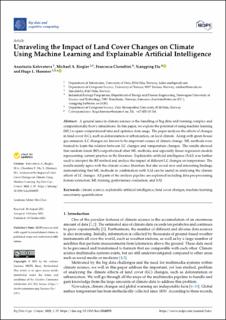| dc.contributor.author | Kolevatova, Anastasiia | |
| dc.contributor.author | Riegler, Michael | |
| dc.contributor.author | Cherubini, Francesco | |
| dc.contributor.author | Hu, Xiangping | |
| dc.contributor.author | Hammer, Hugo Lewi | |
| dc.date.accessioned | 2022-02-04T15:20:27Z | |
| dc.date.available | 2022-02-04T15:20:27Z | |
| dc.date.created | 2021-10-18T20:58:52Z | |
| dc.date.issued | 2021-10-15 | |
| dc.identifier.citation | Big Data and Cognitive Computing. 2021, 5 (4), . | en_US |
| dc.identifier.issn | 2504-2289 | |
| dc.identifier.uri | https://hdl.handle.net/11250/2977266 | |
| dc.description.abstract | A general issue in climate science is the handling of big data and running complex and computationally heavy simulations. In this paper, we explore the potential of using machine learning (ML) to spare computational time and optimize data usage. The paper analyzes the effects of changes in land cover (LC), such as deforestation or urbanization, on local climate. Along with green house gas emission, LC changes are known to be important causes of climate change. ML methods were trained to learn the relation between LC changes and temperature changes. The results showed that random forest (RF) outperformed other ML methods, and especially linear regression models representing current practice in the literature. Explainable artificial intelligence (XAI) was further used to interpret the RF method and analyze the impact of different LC changes on temperature. The
results mainly agree with the climate science literature, but also reveal new and interesting findings, demonstrating that ML methods in combination with XAI can be useful in analyzing the climate effects of LC changes. All parts of the analysis pipeline are explained including data pre-processing, feature extraction, ML training, performance evaluation, and XAI. | en_US |
| dc.description.sponsorship | Francesco Cherubini and Xiangping Hu received support of the Norwegian Research Council through the project MitiStress (project no. 286773). | en_US |
| dc.language.iso | eng | en_US |
| dc.publisher | MDPI | en_US |
| dc.relation.ispartofseries | Big Data and Cognitive Computing;Volume 5, Issue 4 | |
| dc.rights | Navngivelse 4.0 Internasjonal | * |
| dc.rights.uri | http://creativecommons.org/licenses/by/4.0/deed.no | * |
| dc.subject | Climate science | en_US |
| dc.subject | Explainable artificial intelligence | en_US |
| dc.subject | Land cover changes | en_US |
| dc.subject | Machine learning | en_US |
| dc.subject | Uncertainty quantification | en_US |
| dc.title | Unraveling the Impact of Land Cover Changes on Climate Using Machine Learning and Explainable Artificial Intelligence | en_US |
| dc.type | Peer reviewed | en_US |
| dc.type | Journal article | en_US |
| dc.description.version | publishedVersion | en_US |
| dc.rights.holder | © 2021 by the authors | en_US |
| cristin.ispublished | true | |
| cristin.fulltext | original | |
| cristin.qualitycode | 1 | |
| dc.identifier.doi | https://doi.org/10.3390/bdcc5040055 | |
| dc.identifier.cristin | 1946861 | |
| dc.source.journal | Big Data and Cognitive Computing | en_US |
| dc.source.volume | 5 | en_US |
| dc.source.issue | 4 | en_US |
| dc.source.pagenumber | 1-17 | en_US |
| dc.relation.project | Norges forskningsråd: 286773 | en_US |

